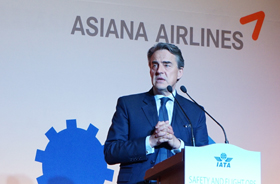International airlines have issued a call for a global standard for air accident investigations after a study revealed reports were available for just 30 per cent of about 1000 crashes over the past decade.
The study by the International Air Transport Association’s Accident Classification Task Force found that reports were available for only about 300 of the crashes and many of those had room for improvement.
Air accident investigations are covered under rules defined by the UN-backed International Civil Aviation Organisation (ICAO).
ICAO’s Accident Investigation Section is responsible for developing and updating Standards and Recommended Practices (SARPs) under a set of rules known Annex 13.
These require member states to investigate accidents taking place in their territory and, for international flights, set out rules on issues such as notification, investigation and reporting.
But adherence to those requirements can differ between jurisdictions.
Speaking at a safety and flight operations conference in Korea on April 24, IATA director general Alexandre de Juniac called for greater cooperation on global standards for air accident investigations.
“Global standards exist, but they are not being applied universally,’’ de Juniac said, pointing to the IATA finding on accident reports. “The investigation process is one of our most important learning tools when building global standards.
“To learn from an accident, we need reports that are complete, accessible and timely. We also need states to fully respect the standards and processes enshrined in global agreements for participation in the investigation by all specified parties.’’
As air traffic grows, so does the number of accidents — even if the accident rate remains stable.
The aviation industry has worked hard to improve safety over the past two decades through improved auditing, better technology and enhanced procedures.
This has allowed aviation to remain by far the safest form of long-distance travel with a commercial aviation accident rate in 2016 of 2.56 major jet hull losses per million flights.
IATA says this is the equivalent to a person taking one flight every day of their life for about 1800 years before being involved in an accident.
But the big drops in the global accident rates made at the end of the 20th century have flattened out in recent years.
Theis has prompted the industry to focus on key areas such as loss of control-Inflight (LOC-I), controlled flight Into terrain (CFIT) and runway safety.
It also looking increasingly at data analysis as a way of generating improvements through an IATA initiative called the Global Aviation Data Management Program, which brings together information from more than 470 organisations.
De Juniac said information provided through this initiative was already helping to identify potential hazards through the analysis of de-identified aircraft flight recorder data.”
“The data generated from the 100,000 safe flights each day can help us understand where the next threat or challenge may arise,’’ de Juniac said. “We need to move ahead in this area with speed.’’
The IATA boss used the forum to take another swipe at the lack of consultation in a decision by the US to ban large electronic devices from the cabins of some flight from the Middle east and North Africa.
He said the measure “challenged public confidence with inconsistencies” and failed to adequately address safety concerns about concentrations of lithium ion batteries in aircraft holds.
He also called for more attention to be paid to the rising problem of drones around airports and their increasing hazard to aviation.
“The great majority of drone owners operate their devices responsibly, but it is also the case that the number of incidents is rising,’’ he said. “There is significant work being developed at ICAO to produce standards for the larger drones that are equipped to share the airspace with manned aircraft.
“However, we need to ensure that the smaller drones, whether intended for recreational or commercial use, are kept out of airspace used for approach and landing operations of air transport. “
























